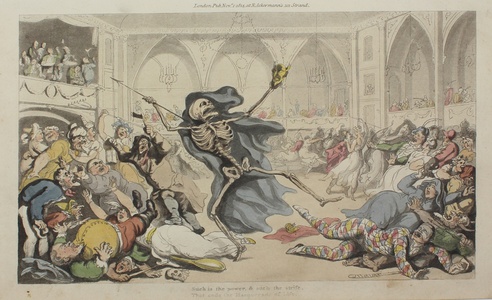| Method | Aquatint with original hand colouring |
| Artist | Thomas Rowlandson |
| Published | London, Pub. Novr. 1. 1814. at R. Ackermann's, 101 Strand. |
| Dimensions | Image 122 x 205 mm, Sheet 140 x 232 mm |
| Notes |
Plate 24 from The English Dance of Death, a tragicomic series of plates by Thomas Rowlandson with accompanying rhyming verse by William Combe. The author's narrative is interrupted momentarily for an aptly placed dream sequence. The author, having mused upon the literary trope of 'Life as a Masquerade,' falls into a slumber and dreams that he himself is at a masque. His companion, appropriately is Death, who asks him to look at his fellow revellers, explaining that the masks we wear in life are sometimes the best indications of our true selves, a reflection of our ambitions, or a mirror to our faults. The Virgin Diana is in life a prostitute. The figure of Justice is an unscrupulous pettifogging lawyer. A beggar receiving alms is truly a Duchess who has never given them. The pugilist is a coward, the poet a dullard, and the tyrannical king a meek and henpecked nobody. At the climax of the dream, Death flamboyantly removes his mask, dealing death to all around him before pointing his fatal dart at the author himself, who thankfully awakes from his dream. Two lines of rhyming verse below the image read: 'Such is the power, & such the strife, / That ends the Masquerade of Life.' The English Dance of Death was Rowlandson and Combe's comedic English take on the popular danse macabre genre. The medieval danse macabre was at once both ribald and sombre, a subversion of social, politic, and religious hierarchies while at the same time a powerful reminder of the inescapable fate that awaits all mortals. The genre proved popular with printmakers, the most famous of which were undoubtedly those of Hans Holbein the Younger and Wenceslaus Hollar, but none are as satyrical as the English Dance of Death. The dance of death as a theme lent itself perfectly to a farcical excoriation of the foibles of Regency England, and Rowlandson and Combe, who had already established their comedic pedigree by collaborating on the popular Dr Syntax series, were the perfect pair to undertake it. In place of the Popes and paupers, the emperors and merchants, and the nuns and alchemists of the originals, in Rowlandson's plates, we find huntsmen and harlots, debauched nobles and pretentious churchmen, quack doctors and gin-shop wastrels, and a whole host of town and country characters beset by a Death who himself runs the full gamut of human emotion, from malice to exasperation, in the varied pursuit of his English prey. Thomas Rowlandson (1756 - 1827) was an English watercolourist and caricaturist. Born in London, the son of a weaver, Rowlandson studied at the Soho Academy from 1765. On leaving school in 1772, he became a student at the Royal Academy and made the first of many trips to Paris where he may have studied under Jean-Baptiste Pigalle. In 1775 he exhibited the drawing Dalilah Payeth Sampson a Visit while in Prison at Gaza at the Royal Academy and two years later received a silver medal for a bas-relief figure. As a printmaker Rowlandson was largely employed by the art publisher Rudolph Ackermann, who in 1809, issued in his Poetical Magazine The Schoolmaster's Tour, a series of plates with illustrative verses by Dr. William Combe. Proving popular, the plates were engraved again in 1812 by Rowlandson himself, and issued under the title The Tour of Dr Syntax in Search of the Picturesque. By 1813 the series had attained a fifth edition, and was followed in 1820 by Dr Syntax in Search of Consolation, Third Tour of Dr Syntax in Search of a Wife in 1821 and also in the same year by The history of Johnny Quae Genus, the little foundling of the late Doctor Syntax. Rowlandson also illustrated work by Smollett, Goldsmith and Sterne, and for The Spirit of the Public Journals (1825), The English Spy (1825), and The Humorist (1831). William Combe (1742-1823) was an English satirist and hack, best known for his authorship of the Dr Syntax series, which were illustrated with his long time collaborator Thomas Rowlandson. In his early life he travelled extensively, but as a product of his mounting debts, spent most of his later life in the King's Bench Prison. In addition to his work on the Dr Syntax series, he also wrote numerous spurious letter series, including some purporting to be by Lord Lyttleton that were widely considered to be authentic by his peers. In addition to his comedic works, he also produced a number of works of topographical history on London, the Thames, Bristol, and York. Condition: Minor time toning to sheet. Trimmed within platemark, as issued, without loss to image. |
| Framing | mounted |
| Price | £75.00 |
| Stock ID | 49192 |

